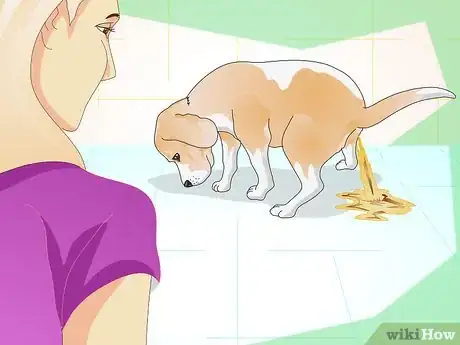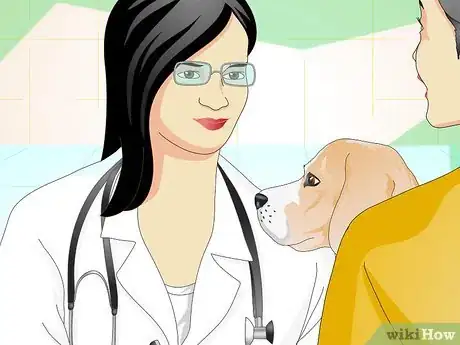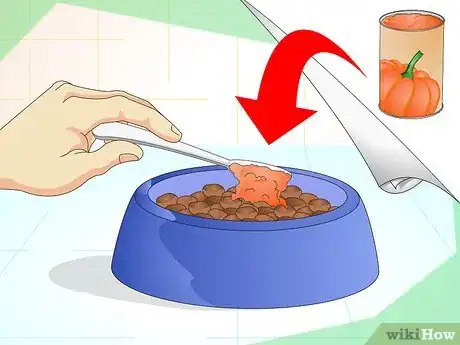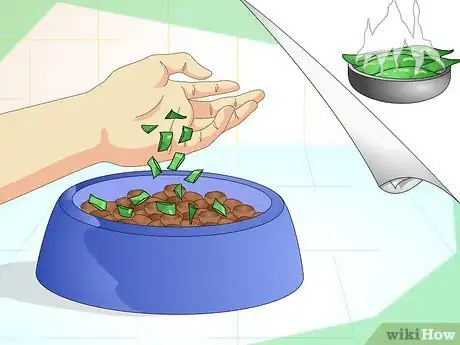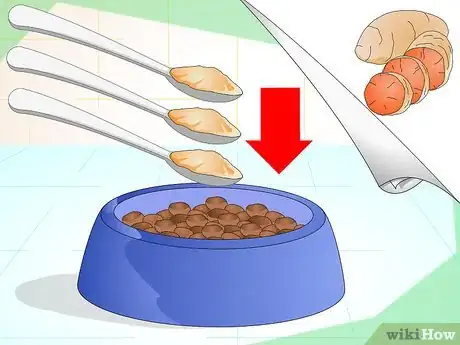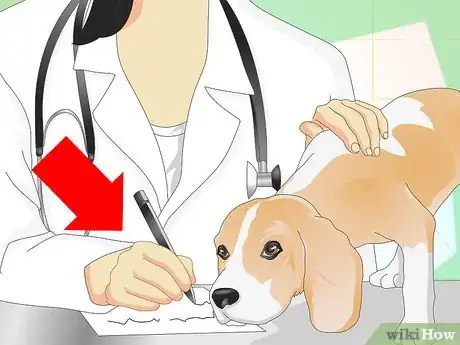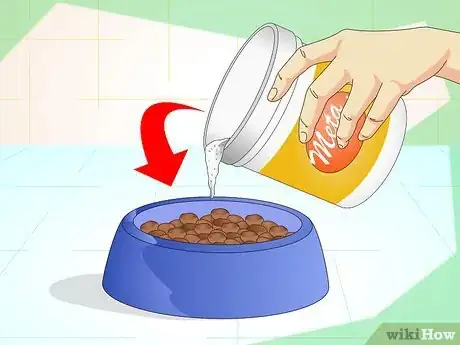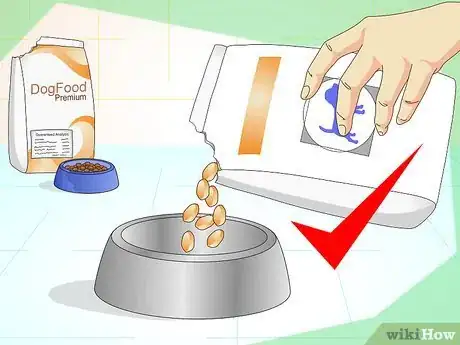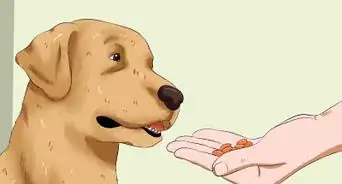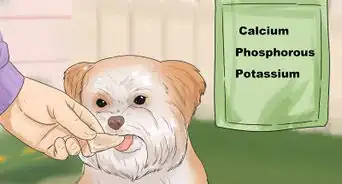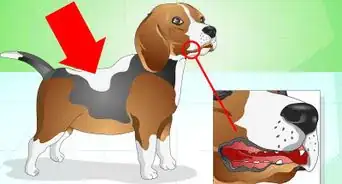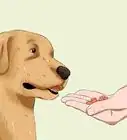This article was co-authored by Brian Bourquin, DVM. Brian Bourquin, better known as “Dr. B” to his clients, is a Veterinarian and the Owner of Boston Veterinary Clinic, a pet health care and veterinary clinic with three locations, South End/Bay Village, the Seaport, and Brookline, Massachusetts. Boston Veterinary Clinic specializes in primary veterinary care, including wellness and preventative care, sick and emergency care, soft-tissue surgery, dentistry. The clinic also provides specialty services in behavior, nutrition, and alternative pain management therapies using acupuncture, and therapeutic laser treatments. Boston Veterinary Clinic is an AAHA (American Animal Hospital Association) accredited hospital and Boston’s first Fear Free Certified Clinic. Brian has over 19 years of veterinary experience and earned his Doctor of Veterinary Medicine from Cornell University.
wikiHow marks an article as reader-approved once it receives enough positive feedback. This article received 12 testimonials and 90% of readers who voted found it helpful, earning it our reader-approved status.
This article has been viewed 727,398 times.
The main reasons for adding fiber to a dog's diet are to encourage good quality and regular bowel movements. It is also used to alleviate constipation and diarrhea, depending on the fiber type. Some diets have higher fiber content to displace calories, increase a feeling of fullness, and help a pet lose weight. You can add fiber to a dog’s diet in a variety of ways from over-the-counter fiber supplements to incorporating healthy human foods into a dog's diet.
Steps
Evaluating the Need for Additional Fiber in Your Dog’s Diet
-
1Check your dog’s current food. Many foods have adequate levels of fiber already provided. The ‘Guaranteed Analysis’ provided on your pets’ food bag should note the maximum crude fiber concentration. Most pet foods contain about 5% crude fiber, and this is often adequate for the average healthy dog.[1]
-
2Observe your dog. If your dog is constipated or has diarrhea, this could be something a simple stomach bug, parasites, other gastrointestinal diseases, or strain due to an enlarged prostate or mass impeding the passage of stool.[2] Observe your dog to see if the symptoms persist for more than two days.Advertisement
-
3Take your dog to the veterinarian. The symptoms of constipation can overlap with those of urinary obstruction, which is very serious. If you see your pet repeatedly straining then a vet check is strongly advised. Ask your vet to include a rectal exam. If the primary issue turns out to be one of diet and digestion, your vet may suggest fiber supplementation.EXPERT TIPBrian Bourquin, better known as “Dr. B” to his clients, is a Veterinarian and the Owner of Boston Veterinary Clinic, a pet health care and veterinary clinic with three locations, South End/Bay Village, the Seaport, and Brookline, Massachusetts. Boston Veterinary Clinic specializes in primary veterinary care, including wellness and preventative care, sick and emergency care, soft-tissue surgery, dentistry. The clinic also provides specialty services in behavior, nutrition, and alternative pain management therapies using acupuncture, and therapeutic laser treatments. Boston Veterinary Clinic is an AAHA (American Animal Hospital Association) accredited hospital and Boston’s first Fear Free Certified Clinic. Brian has over 19 years of veterinary experience and earned his Doctor of Veterinary Medicine from Cornell University.Veterinarian

 Brian Bourquin, DVM
Brian Bourquin, DVM
VeterinarianOur Expert Agrees: If you're considering giving your dog fiber to treat loose stools or diarrhea, take it in to the veterinarian first. Most fortified diets contain all the fiber your dog needs, so the problem could be something like internal parasites, a food allergy, or something more serious, like pancreatitis.
Adding Fiber to Your Dog’s Diet
-
1Incorporate canned pumpkin pulp into your dog's food. A small dog only needs about 1 tbsp. per feeding. A large dog of 50 lbs. (22.67 kg) or more can use 1/4 cup (236.58 ml) per meal.[3]
- Use discretion when purchasing since canned pumpkin pulp is not the same thing as pumpkin pie mix, which has additives and sugar that aren't healthy for dogs.[4]
-
2Steam green beans. Fresh green beans are an additional source of fiber for dogs. Prepare a handful by lightly steaming in a microwave, then completely cooling. Finely chop or blend them then incorporate them into your dog's meal.
- Raw green beans are less digestible, so your dog won't experience all of the possible nutritional benefits. However, they make a good snack during games and training.
-
3Serve sweet potatoes. A single medium-sized sweet potato contains over 3 grams of fiber. To serve one to your dog, peel it first and chop it into small cubes. Put the cubes into a shallow bowl with a small amount of water, cover with plastic wrap, and steam in the microwave until you can easily pierced them with a fork. Mash with a fork, then incorporate 1-3 tbsp. into your dog's main meal.
-
4Consult your dog’s veterinarian. Be aware that these and other veggies may also increase other nutrients, including potassium. These may not be beneficial for your pet if they have other or concurrent health problems, such as kidney disease. Your vet can help determine the best vegetables based on any other conditions your pet may have.
-
5Drop a spoonful of bran flakes, cooked oats, or millet into your dog's meal. Whole grains are another ideal and inexpensive way to supplement dog meals with fiber. Some of these products may be fortified with vitamins or other supplements, so be sure to examine all nutrition information before using commercially available processed foods.
-
6Add an over-the-counter fiber additive. You can use Metamucil or other OTC fiber additives for a few days to help your dog recover from an episode of constipation.[5] Sprinkle it over your dog's food for the fastest way to resume regular bowel movements. Use about 1/2 tsp. for small dogs, or up to 2 Tbsp. per meal for very large dogs. Add a small amount of water to blend the fiber.
- Use sparingly and for no more than two days to ensure you don't encounter the opposite problem of dog diarrhea.
-
7Try a new or different diet. Switching to a commercial diet with a higher listed fiber content (or to a veterinary prescription such as Hill's w/d, Royal Canin GI Fiber Response, or Purina's DCO) might be an easier way to supplement additional fiber without extra shopping or preparation steps. You may have to purchase or order prescription diets from your veterinarian, or you may have to obtain a written prescription for the food to purchase it from a pet food retailer.
-
8Don’t overdo it. 'Fiber' is a term that describes many different polysaccharides and not all fiber is created equally. Different forms of fiber will have variable effects on water absorption, digestion, and fermentation within the intestine. This could lead to undesirable effects, including flatulence, bloating, or diarrhea.[6] If you experience this with your dog, try changing the type of fiber or lowering the amount that you’re adding.
- Adding excessive amounts of fiber to the diet for the goal of weight loss can also have dangerous effects by diluting essential nutrients, calories, and decreasing the absorption of some minerals.
Expert Q&A
-
QuestionMy dog has started to have problems with her anal glands. What food supplement should I give her?
 Pippa Elliott, MRCVSDr. Elliott, BVMS, MRCVS is a veterinarian with over 30 years of experience in veterinary surgery and companion animal practice. She graduated from the University of Glasgow in 1987 with a degree in veterinary medicine and surgery. She has worked at the same animal clinic in her hometown for over 20 years.
Pippa Elliott, MRCVSDr. Elliott, BVMS, MRCVS is a veterinarian with over 30 years of experience in veterinary surgery and companion animal practice. She graduated from the University of Glasgow in 1987 with a degree in veterinary medicine and surgery. She has worked at the same animal clinic in her hometown for over 20 years.
Veterinarian Some dogs suffer from anal gland issues if their stool isn't firm and bulky enough. If that is the case you're looking to make her stool more voluminous but maintain firmness. Any of the suggestions mentioned in the article above should do the trick.
Some dogs suffer from anal gland issues if their stool isn't firm and bulky enough. If that is the case you're looking to make her stool more voluminous but maintain firmness. Any of the suggestions mentioned in the article above should do the trick. -
QuestionCan fiber caplets be used as a substitute for powdered psyllium husk?
 Pippa Elliott, MRCVSDr. Elliott, BVMS, MRCVS is a veterinarian with over 30 years of experience in veterinary surgery and companion animal practice. She graduated from the University of Glasgow in 1987 with a degree in veterinary medicine and surgery. She has worked at the same animal clinic in her hometown for over 20 years.
Pippa Elliott, MRCVSDr. Elliott, BVMS, MRCVS is a veterinarian with over 30 years of experience in veterinary surgery and companion animal practice. She graduated from the University of Glasgow in 1987 with a degree in veterinary medicine and surgery. She has worked at the same animal clinic in her hometown for over 20 years.
Veterinarian It's not a good idea. Whilst you may get away with it, it can be tricky to get the dosage correct. Remember, the caplets are designed for people and therefore much more concentrated fiber. In addition, there's a risk of choking if the dog doesn't drink water straight after taking the caplet. Also, always read the packaging and remember that any product containing an artificial sweetener (such as Xylitol) is NOT suitable for dogs. If your can't source psyllium husk, then consider other options such as pumpkin or the fresh vegetables suggested above.
It's not a good idea. Whilst you may get away with it, it can be tricky to get the dosage correct. Remember, the caplets are designed for people and therefore much more concentrated fiber. In addition, there's a risk of choking if the dog doesn't drink water straight after taking the caplet. Also, always read the packaging and remember that any product containing an artificial sweetener (such as Xylitol) is NOT suitable for dogs. If your can't source psyllium husk, then consider other options such as pumpkin or the fresh vegetables suggested above. -
QuestionWhat diet is best for my eight-year-old dog with diabetes?
 Pippa Elliott, MRCVSDr. Elliott, BVMS, MRCVS is a veterinarian with over 30 years of experience in veterinary surgery and companion animal practice. She graduated from the University of Glasgow in 1987 with a degree in veterinary medicine and surgery. She has worked at the same animal clinic in her hometown for over 20 years.
Pippa Elliott, MRCVSDr. Elliott, BVMS, MRCVS is a veterinarian with over 30 years of experience in veterinary surgery and companion animal practice. She graduated from the University of Glasgow in 1987 with a degree in veterinary medicine and surgery. She has worked at the same animal clinic in her hometown for over 20 years.
Veterinarian What to feed diabetic dogs is controversial, and there is no easy answer. On the whole, it's generally agreed that carbohydrates are digested more quickly and cause spikes in blood sugar level, so it seems wise to look for a food that contains slowly-digested carbohydrates, such as vegetables, legumes, fruits, and some whole grains. Ingredients such as sweet potato and brown rice are intermediately digested, and OK for most diabetics, while highly processed ingredients, such as white rice or bread, are best avoided. Protein takes longer to digest, so source a food that has a named meat (e.g. lamb, beef, or chicken) heading up the ingredient list.
What to feed diabetic dogs is controversial, and there is no easy answer. On the whole, it's generally agreed that carbohydrates are digested more quickly and cause spikes in blood sugar level, so it seems wise to look for a food that contains slowly-digested carbohydrates, such as vegetables, legumes, fruits, and some whole grains. Ingredients such as sweet potato and brown rice are intermediately digested, and OK for most diabetics, while highly processed ingredients, such as white rice or bread, are best avoided. Protein takes longer to digest, so source a food that has a named meat (e.g. lamb, beef, or chicken) heading up the ingredient list.
Warnings
- Never pursue any home remedies without contacting your veterinarian first. If your dog is experiencing any bowel problems, a medically trained professional can recognize health issues and help create a plan of action to prevent dog constipation.⧼thumbs_response⧽
References
- ↑ Mark Morris Institute, Small Animal Clinical Nutrition, 4th ed. Marceline: Walsworth, 2000. Print.
- ↑ Washabau, R; Day, M. J.: Canine and Feline Gastroenterology Ed 1 St. Louis, Elsevier, 2013 p 109
- ↑ Mark Morris Institute, Small Animal Clinical Nutrition, 4th ed. Marceline: Walsworth, 2000. Print.
- ↑ http://www.vetinfo.com/dog-fiber-recommendations.html
- ↑ http://www.drsfostersmith.com/pic/article.cfm?dept_id=0&siteid=12&acatid=284&aid=460
- ↑ http://www.vetinfo.com/dog-fiber-recommendations.html
About This Article
To add fiber to your dog's diet, add a spoonful of bran flakes or cooked oats to your dog's food every day. You can also serve your dog steamed green beans or sweet potatoes, which are both great sources of fiber. A tablespoon of canned pumpkin pulp will work too. If your dog isn't a fan of human food, try adding an over-the-counter fiber additive to its food every day instead. For help figuring out how much fiber your dog actually needs, keep reading!

